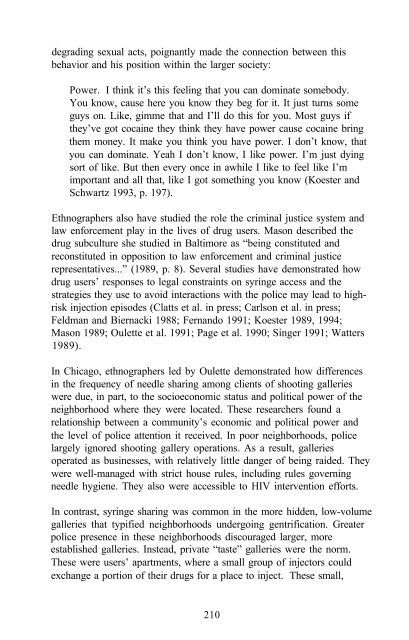The Context of HIV Risk Among Drug Users and Their Sexual Partners
The Context of HIV Risk Among Drug Users and Their Sexual Partners
The Context of HIV Risk Among Drug Users and Their Sexual Partners
You also want an ePaper? Increase the reach of your titles
YUMPU automatically turns print PDFs into web optimized ePapers that Google loves.
degrading sexual acts, poignantly made the connection between this<br />
behavior <strong>and</strong> his position within the larger society:<br />
Power. I think it’s this feeling that you can dominate somebody.<br />
You know, cause here you know they beg for it. It just turns some<br />
guys on. Like, gimme that <strong>and</strong> I’ll do this for you. Most guys if<br />
they’ve got cocaine they think they have power cause cocaine bring<br />
them money. It make you think you have power. I don’t know, that<br />
you can dominate. Yeah I don’t know, I like power. I’m just dying<br />
sort <strong>of</strong> like. But then every once in awhile I like to feel like I’m<br />
important <strong>and</strong> all that, like I got something you know (Koester <strong>and</strong><br />
Schwartz 1993, p. 197).<br />
Ethnographers also have studied the role the criminal justice system <strong>and</strong><br />
law enforcement play in the lives <strong>of</strong> drug users. Mason described the<br />
drug subculture she studied in Baltimore as “being constituted <strong>and</strong><br />
reconstituted in opposition to law enforcement <strong>and</strong> criminal justice<br />
representatives...” (1989, p. 8). Several studies have demonstrated how<br />
drug users’ responses to legal constraints on syringe access <strong>and</strong> the<br />
strategies they use to avoid interactions with the police may lead to highrisk<br />
injection episodes (Clatts et al. in press; Carlson et al. in press;<br />
Feldman <strong>and</strong> Biernacki 1988; Fern<strong>and</strong>o 1991; Koester 1989, 1994;<br />
Mason 1989; Oulette et al. 1991; Page et al. 1990; Singer 1991; Watters<br />
1989).<br />
In Chicago, ethnographers led by Oulette demonstrated how differences<br />
in the frequency <strong>of</strong> needle sharing among clients <strong>of</strong> shooting galleries<br />
were due, in part, to the socioeconomic status <strong>and</strong> political power <strong>of</strong> the<br />
neighborhood where they were located. <strong>The</strong>se researchers found a<br />
relationship between a community’s economic <strong>and</strong> political power <strong>and</strong><br />
the level <strong>of</strong> police attention it received. In poor neighborhoods, police<br />
largely ignored shooting gallery operations. As a result, galleries<br />
operated as businesses, with relatively little danger <strong>of</strong> being raided. <strong>The</strong>y<br />
were well-managed with strict house rules, including rules governing<br />
needle hygiene. <strong>The</strong>y also were accessible to <strong>HIV</strong> intervention efforts.<br />
In contrast, syringe sharing was common in the more hidden, low-volume<br />
galleries that typified neighborhoods undergoing gentrification. Greater<br />
police presence in these neighborhoods discouraged larger, more<br />
established galleries. Instead, private “taste” galleries were the norm.<br />
<strong>The</strong>se were users’ apartments, where a small group <strong>of</strong> injectors could<br />
exchange a portion <strong>of</strong> their drugs for a place to inject. <strong>The</strong>se small,<br />
210
















